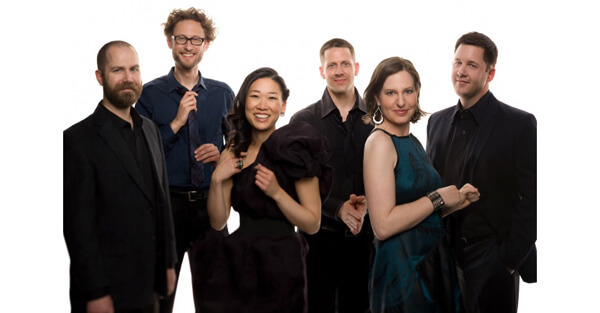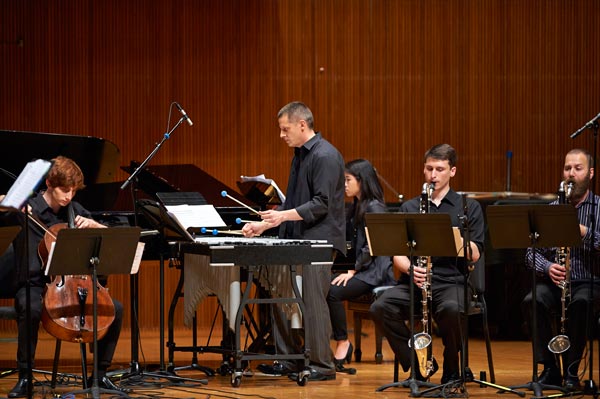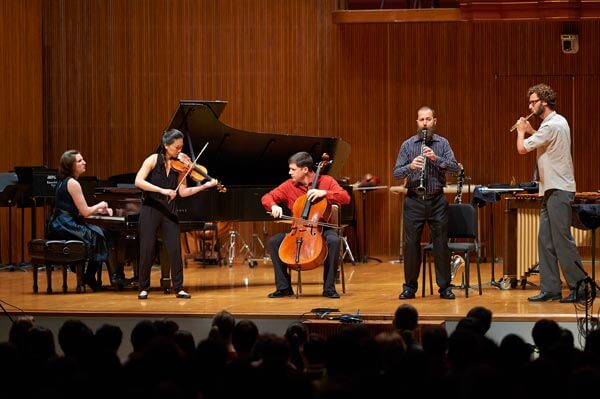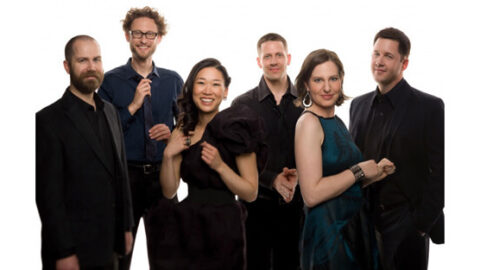 Three-time Grammy winners eighth blackbird returned to their nest for a concert with the Oberlin Conservatory Contemporary Music Ensemble at Warner Concert Hall on October 4, 2013. Most notable on the varied program were three world premieres from three composers, each of which explored the interplay of textures and surfaces, though in thoroughly different ways. Two of these, by Oberlin professors Thomas Lopez and Peter Swendsen, confined themselves to the sonic possibilities of eighth blackbird’s Pierrot sextet configuration — flutes (Tim Munro), clarinets (Michael Maccaferri), violin/viola (Yvonne Lam), cello (Nicholas Photinos), percussion (Matthew Duvall), and piano (Lisa Kaplan). The third, by composer-in-residence Benjamin Broening, used a larger and more diverse ensemble of CME-only players, but to similar effects.
Three-time Grammy winners eighth blackbird returned to their nest for a concert with the Oberlin Conservatory Contemporary Music Ensemble at Warner Concert Hall on October 4, 2013. Most notable on the varied program were three world premieres from three composers, each of which explored the interplay of textures and surfaces, though in thoroughly different ways. Two of these, by Oberlin professors Thomas Lopez and Peter Swendsen, confined themselves to the sonic possibilities of eighth blackbird’s Pierrot sextet configuration — flutes (Tim Munro), clarinets (Michael Maccaferri), violin/viola (Yvonne Lam), cello (Nicholas Photinos), percussion (Matthew Duvall), and piano (Lisa Kaplan). The third, by composer-in-residence Benjamin Broening, used a larger and more diverse ensemble of CME-only players, but to similar effects.

Lopez’s Skipping Stones mirrored double sextets, eighth blackbird to the left and CME members to the right. Remarkably, they played without a conductor. Sounds of slippery surfaces from cymbals, tinkling percussion and bowed waterphone dominated at the outset. The music unfolded as a series of episodes with an individual eighth blackbird member initiating each sequence as if flat stones whipped across calm waters. The CME players echoed and repeated the figures as ever-widening rings and sparkling water drops dancing on the surface. Tart bleats on clarinet were echoed on penny-whistle. Shimmering viola runs resounded on glockenspiel and waterphone. Piano reverberated in tam-tam shimmers and tinkling triangle. All the while, Lopez’s electronics perfectly evoked the ambient sounds of a summer afternoon at the lake.
What the Light Was Like is Broening’s conceptual setting of Amy Clampitt’s poem of the same name, an autumnal reminiscence of summer’s glow. CME director Timothy Weiss conducted 16 student performers in this atmospheric five movement piece. Glistening light and glimmering colors of dawn crept over the aural horizon, giving way to a full burst of sunlight in dazzling cymbals, tams-tams, and harp. The rich glow of morning brought bright emerald greens and butter gold. Sonorous cello, bass, piano, and bass clarinet sounds signaled a mantle of fog rolling in off the shore adding mystery and diffusing the color. The mist thinned and gave way to resurgent colors in the strings, reeds, and horns, taken to the edge of cacophony. The watery surface of a deep pool reflected sparkling light as it flowed into a swirling eddy of harp, piano, and low strings, a journey down an abstract Moldau from the perspective of the light.

Six Ways Through a Glass of Absinthe by Swendsen returned to the conceit of doubling eighth blackbird’s instrumentation, this time with the sextets interleaved rather than mirrored, with Weiss conducting. Shifting tempos and tight rhythmic structures required great precision from the players. The paired instruments shifted from unison playing to contrasting styles and speeds. A sudden slower pace was accompanied by a muted alarm clock bell and static-filled metronomic clicks in the electronics. The flutes initiated a pattern echoed in the strings, the cellos sounding like bellows with a heavy-breathing rhythm and texture. As the speed accelerated to a boil, prerecorded electronics brought forth the sounds of a Paris street carnival. Inspired by the iconic Pablo Picasso cubist painting Glass of Absinthe, which hangs in the Allen Memorial Art Museum at Oberlin College, this was the most abstract of the three premieres, and also the most exhilarating.
The balance of the program was no less entertaining than the premieres. Kaplan composed whirligig (2013) on a dare from composer Nico Muhly to create an amusement they could play piano four-hands at a joint concert in Chicago last fall. For this performance, Kaplan asked three different partners to join her for one movement each – ensemble mates Lam and Photinos, and her piano teacher at Oberlin, Sanford Margolis. The piece is a delightful romp. While Kaplan’s partners attempted to play their parts, she played over and around them them in increasingly invasive ways until the partners were nearly forced off the end of the keyboard. Amidst all the theatrics, the music is masterful with staggering rhythms. The final boogie-woogie movement had a lively blues texture, filled with dueling cluster chords.

Kaija Saariaho’s mesmerizing Amers (1992) featured Photinos as cello soloist with 13 CME colleagues playing the chamber orchestra accompaniment. While the playing was excellent throughout this tour-de-force exhibition of Photinos extraordinary skill in the contemporary repertoire, there were occasional sound balance problems with ensemble playing muffling the soloist. In the first movement from Tied Shifts (2004) by Derek Bermel, eighth blackbird showed off their celebrated skill at playing choreographed versions of challenging work from memory. Starting with only Lam and Photinos on stage, they acted out the gradual buildup and variation in the work. Other members pranced on stage as their parts began. As the work progressed the players merged in various groupings, then separated, animating the score in a most amusing fashion.

Working shoulder to shoulder with eighth blackbird, the Oberlin Contemporary Music Ensemble showed itself able to play at a very high level of excellence. That achievement will be further validated in November when they play the three works premiered on this concert at the 13th annual Third Practice Festival at University of Richmond (Virginia) where eighth blackbird is ensemble-in-residence and Broening is a faculty member and Artistic Director of the festival.
























